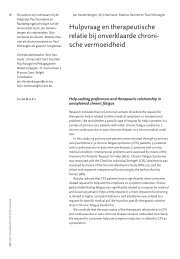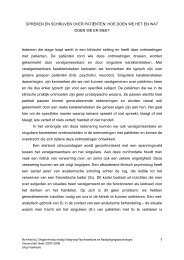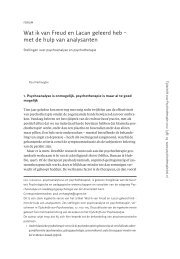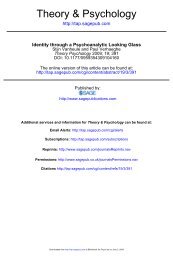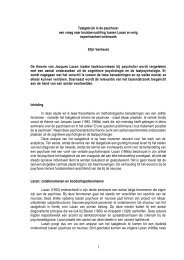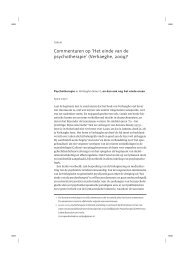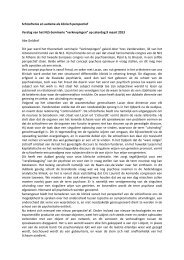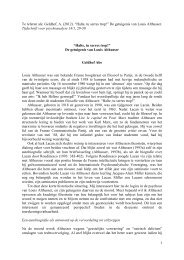psychotherapy and research
psychotherapy and research
psychotherapy and research
You also want an ePaper? Increase the reach of your titles
YUMPU automatically turns print PDFs into web optimized ePapers that Google loves.
STIJN VANHEULE 95A third characteristic of r<strong>and</strong>omized controlled trials is that they build onr<strong>and</strong>omization, meaning that patients are r<strong>and</strong>omly assigned to one treatmentcondition or to another, <strong>and</strong> concealment, meaning that patients do notknow to which treatment module they were allocated. This obviously makessense if one wants to know whether or not a pharmaceutical is effective fortreating a medical condition. After all, in medical studies it has been estimatedthat insufficiently rigorous concealment of treatment allocation overestimatestreatment effects by 41% (Schulz et al. 1995).Yet, what does the idea of concealment mean for <strong>psychotherapy</strong> <strong>research</strong>?Any notion that patients do not know anything about the treatment conditionthey are in implies that people do not know the difference betweendiverse psychotherapeutic treatments, <strong>and</strong> that they cannot detect differencesbetween CBT <strong>and</strong> psychoanalytic therapy. It also implies that peopleseeking help for mental problems do not have personal preferences or ideasof what a good <strong>psychotherapy</strong> is like – ideas with which they make judgementson the match or mismatch between their preferences <strong>and</strong> the treatmentmodule offered. Empirical studies on both these topics are rare, butthose existing indicate that, on the contrary, people do have preferences forspecific therapies (e.g. Frovenholt et al. 2007) <strong>and</strong> they also have private laytheories on what good therapy looks like (e.g. Philips et al. 2007). Both theseaspects make me doubt whether treatment allocation can ever be trulyconcealed in <strong>psychotherapy</strong> RCTs. Serious tests on the success of treatmentconcealment are usually not included in <strong>psychotherapy</strong> RCTs, <strong>and</strong>, moreessentially, fundamental evidence supporting the possibility of proper treatmentconcealment is lacking. As a result, an important source of bias mightaffect the results.Moreover, r<strong>and</strong>om assignment to modalities of treatment implies that thatthe unique specificity of the issues a patient may bring to a consultation forher/his disorder is neglected. In RCT studies, all attention goes to nomotheticcharacteristics of disorders (i.e. to issues commonly associated withdisorders). Idiographic characteristics of patients are neglected. The lattermeans that strictly individual characteristics or concerns typical for a particularpatient are not taken into account. We can fundamentally questionwhether this procedure is appropriate for the discipline of <strong>psychotherapy</strong>.Imagine that someone consults a therapist for a phobic complaint <strong>and</strong> wantsimmediate relief from it <strong>and</strong> that psychodynamic treatment is allocated forthis person.Would we be surprised if the outcome was not good? Or perhapssomeone else consults a therapist, also for a phobic complaint, but situatesits outset around the moment her mother died, <strong>and</strong> this patient is exposed toa treatment with systematic desensitization. Again would we be surprised ifthe outcome was not good? I think practising psychotherapists would not besurprised in either case. Clinicians typically do not consider disorders ortreatment conditions as easily generalizable across cases. The diagnosticassessment psychotherapists apply entails much more than identifying



